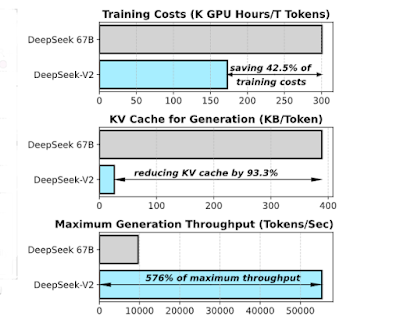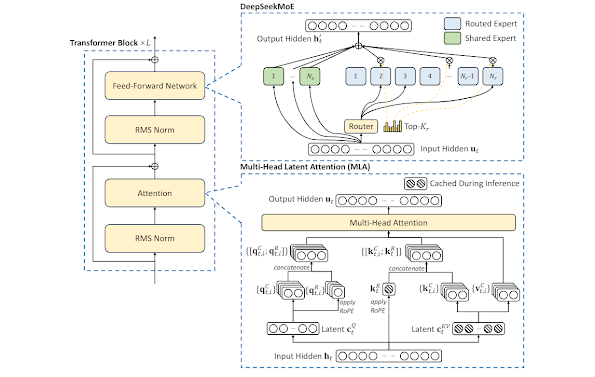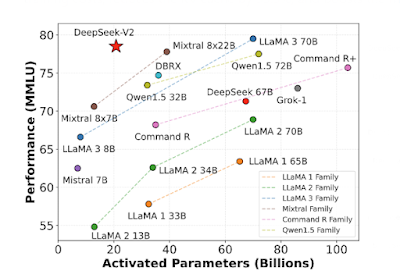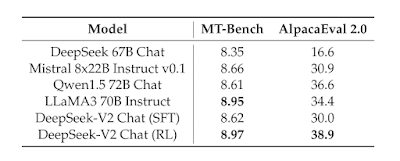Introduction
The evolution of artificial intelligence (AI) has been marked by significant milestones, with language models playing a crucial role in this journey. Among these models, the Mixture-of-Experts (MoE) language models have emerged as a game-changer. The concept of MoE, which originated in 1991, involves a system of separate networks, each specializing in a different subset of training cases. This unique approach has led to substantial improvements in model performance and efficiency, pushing the boundaries of what’s possible in complex language tasks.
However, the path of progress is not without its challenges. MoE models grapple with issues such as balancing computational costs and the increasing demand for high-quality outputs. Memory requirements and fine-tuning also pose significant hurdles. To overcome these challenges, DeepSeek-AI, a team dedicated to advancing the capabilities of AI language models, introduced DeepSeek-V2. Building on the foundation laid by its predecessor, DeepSeek 67B, DeepSeek-V2 represents a leap forward in the field of AI.
What is DeepSeek-V2?
DeepSeek-V2 is a state-of-the-art Mixture-of-Experts (MoE) language model that stands out due to its economical training and efficient inference capabilities. It is a powerful model that comprises a total of 236 billion parameters, with 21 billion activated for each token.
Model Variant(s)
DeepSeek-V2 comes in various variants, including the base model suitable for general tasks and specialized versions like DeepSeek-V2-Chat, which is optimized for conversational AI applications. Each variant is tailored to excel in specific domains, leveraging the model’s innovative architecture. these variants are not just random iterations of the model. They are carefully designed and fine-tuned to cater to specific use-cases.
Key Features of DeepSeek-V2
DeepSeek-V2 is characterized by several unique features:
- Economical Training: DeepSeek-V2 is designed to be cost-effective. When compared to its predecessor, DeepSeek 67B, it saves 42.5% of training costs, making it a more economical choice for training large language models.
- Efficient Inference: Efficiency is at the core of DeepSeek-V2. It reduces the Key-Value (KV) cache by 93.3%, significantly improving the efficiency of the model. Furthermore, it boosts the maximum generation throughput by 5.76 times, enhancing the model’s performance.
- Strong Performance: DeepSeek-V2 doesn’t compromise on performance. It achieves stronger performance compared to its predecessor, DeepSeek 67B, demonstrating the effectiveness of its design and architecture.
- Innovative Architecture: DeepSeek-V2 includes innovative features such as Multi-head Latent Attention (MLA) and DeepSeekMoE architecture. These features allow for significant compression of the KV cache into a latent vector and enable the training of strong models at reduced costs through sparse computation.
Capabilities/Use Case of DeepSeek-V2
DeepSeek-V2 excels in various domains, showcasing its versatility:
- Natural and Engaging Conversations: DeepSeek-V2 is adept at generating natural and engaging conversations, making it an ideal choice for applications like chatbots, virtual assistants, and customer support systems.
- Wide Domain Expertise: DeepSeek-V2 excels in various domains, including math, code, and reasoning. This wide domain expertise makes it a versatile tool for a range of applications.
- Top-Tier Performance: DeepSeek-V2 has demonstrated top-tier performance in AlignBench, surpassing GPT-4 and closely rivaling GPT-4-Turbo. This showcases its capability to deliver high-quality outputs in diverse tasks.
- Support for Large Context Length: The open-source model of DeepSeek-V2 supports a 128K context length, while the Chat/API supports 32K. This support for large context lengths enables it to handle complex language tasks effectively.
How does DeepSeek-V2 work?/ Architecture/Design
DeepSeek-V2 is built on the foundation of the Transformer architecture, a widely used model in the field of AI, known for its effectiveness in handling complex language tasks. However, DeepSeek-V2 goes beyond the traditional Transformer architecture by incorporating innovative designs in both its attention module and Feed-Forward Network (FFN).
The attention module of DeepSeek-V2 employs a unique design called Multi-head Latent Attention (MLA). MLA utilizes low-rank key-value joint compression to significantly compress the Key-Value (KV) cache into a latent vector. This innovative approach eliminates the bottleneck of inference-time key-value cache, thereby supporting efficient inference.
In addition to the MLA, DeepSeek-V2 also adopts the DeepSeekMoE architecture for its FFNs. DeepSeekMoE is a high-performance MoE architecture that enables the training of strong models at an economical cost. It leverages device-limited routing and an auxiliary loss for load balance, ensuring efficient scaling and expert specialization.
Apart from these innovative architectures, DeepSeek-V2 also follows the settings of DeepSeek 67B for other details such as layer normalization and the activation function in FFNs, unless specifically stated otherwise. This combination of innovative designs and proven techniques makes DeepSeek-V2 a powerful and efficient language model.
Performance Evaluation with Other Models
DeepSeek-V2 has demonstrated remarkable performance on both standard benchmarks and open-ended generation evaluation. Even with only 21 billion activated parameters, DeepSeek-V2 and its chat versions achieve top-tier performance among open-source models, becoming the strongest open-source MoE language model.
The model’s performance has been evaluated on a wide range of benchmarks in English and Chinese, and compared with representative open-source models. As highlighted in above figure 1(a) DeepSeek-V2 achieves top-ranking performance on MMLU with only a small number of activated parameters.
DeepSeek-V2 Chat (SFT) and DeepSeek-V2 Chat (RL) have also been evaluated on open-ended benchmarks. Notably, DeepSeek-V2 Chat (RL) achieves a 38.9 length-controlled win rate on AlpacaEval 2.0, an 8.97 overall score on MT-Bench, and a 7.91 overall score on AlignBench. These evaluations demonstrate that DeepSeek-V2 Chat (RL) has top-tier performance among open-source chat models. In Chinese, DeepSeek-V2 Chat (RL) outperforms all open-source models and even beats most closed-source models.

source - https://arxiv.org/pdf/2405.04434
Bold denotes the best and underline denotes the second-best.
As detailed in table above, DeepSeek-V2 significantly outperforms DeepSeek 67B on almost all benchmarks, achieving top-tier performance among open-source models. When compared with other models such as Qwen1.5 72B, Mixtral 8x22B, and LLaMA3 70B, DeepSeek-V2 demonstrates overwhelming advantages on the majority of English, code, and math benchmarks. It also outperforms these models overwhelmingly on Chinese benchmarks.
Finally, it’s worth mentioning that certain prior studies incorporate SFT data during the pre-training stage, whereas DeepSeek-V2 has never been exposed to SFT data during pre-training. Despite this, DeepSeek-V2 still demonstrates substantial improvements in GSM8K, MATH, and HumanEval evaluations compared with its base version. This progress can be attributed to the inclusion of SFT data, which comprises a considerable volume of math and code-related content. In addition, DeepSeek-V2 Chat (RL) further boosts the performance on math and code benchmarks.
Strategic Enhancements in DeepSeek-V2: A Comparative Analysis
DeepSeek-V2 distinguishes itself with its cost-effective training process and efficient inference mechanism. This model achieves high-level performance without demanding extensive computational resources. It is designed with a massive 236 billion parameters, activating 21 billion of them for each token processed. The model’s pretraining on a varied and quality-rich corpus, complemented by Supervised Fine-Tuning (SFT) and Reinforcement Learning (RL), maximizes its potential.
In contrast, Mixtral-8x22B, a Sparse Mixture-of-Experts (SMoE) model, boasts 176 billion parameters, with 44 billion active during inference. It demonstrates proficiency in several languages, including English, French, Italian, German, and Spanish, and exhibits robust capabilities in mathematics and coding. Meanwhile, Llamma-3-70B, which is tailored for conversational applications, surpasses many open-source chat models in standard industry benchmarks, although its total parameter count remains unspecified.
Ultimately, DeepSeek-V2’s frugal training requirements and effective inference position it as a standout model. Its substantial parameter count, coupled with strategic Supervised Fine-Tuning (SFT) and Reinforcement Learning (RL), significantly bolsters its functionality. These attributes solidify DeepSeek-V2’s status as a formidable presence in the arena of AI language models.
How to Access and Use DeepSeek-V2?
DeepSeek-V2 is an open-source model that is accessible through its GitHub repository. It can be used both locally and online, offering flexibility in its usage. For online use, demo links are provided by HuggingFace, a platform that hosts thousands of pre-trained models in multiple languages.
Despite the constraints of HuggingFace, which may result in slower performance when running on GPUs, DeepSeek-AI has provided a dedicated solution to optimize the model’s performance effectively. This ensures that users can leverage the full potential of DeepSeek-V2 in their applications. The model is not only open-source but also commercially usable, with a clear licensing structure detailed in the GitHub repository.
Limitations And Future Work
While DeepSeek-V2 represents a significant advancement in the field of AI, it shares common limitations with other large language models (LLMs). One such limitation is the lack of ongoing knowledge updates after pre-training, which means the model’s knowledge is frozen at the time of training and does not update with new information. Another potential issue is the generation of non-factual information, a challenge faced by many AI models.
However, it’s important to note that these limitations are part of the current state of AI and are areas of active research. Future work by DeepSeek-AI and the broader AI community will focus on addressing these challenges, continually pushing the boundaries of what’s possible with AI.
Conclusion
DeepSeek-V2 represents a significant milestone in the evolution of MoE language models. Its unique combination of performance, efficiency, and cost-effectiveness positions it as a leading solution in the AI landscape. As AI continues to advance, DeepSeek-V2 will undoubtedly play a pivotal role in shaping the future of language modeling.
Source
research paper : https://arxiv.org/abs/2405.04434
research document : https://arxiv.org/pdf/2405.04434
GitHub repo : https://github.com/deepseek-ai/DeepSeek-V2
Model weights:
https://huggingface.co/deepseek-ai/DeepSeek-V2
https://huggingface.co/deepseek-ai/DeepSeek-V2-Chat





No comments:
Post a Comment